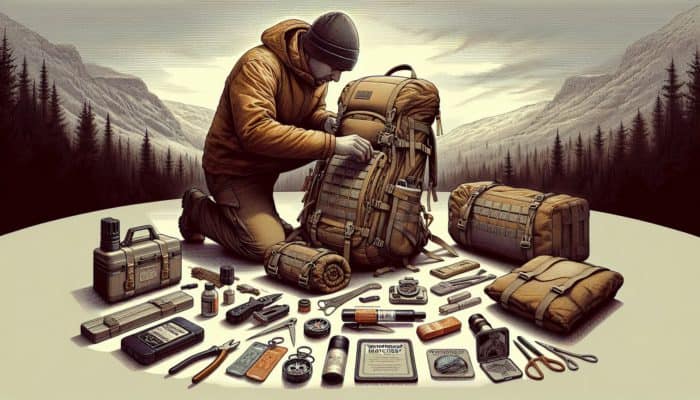Essential Preparations for Thriving in Remote Survival Scenarios
How to Strategically Select and Pack Your Vital Survival Equipment

When embarking on an adventure into remote areas, it is imperative to meticulously choose and pack the appropriate gear to enhance your chances of survival. Every item within your backpack should fulfil a specific function, equipping you with the necessary tools to tackle unforeseen challenges. A carefully curated selection of equipment not only improves your survival prospects but also ensures your comfort during the journey. Initiate your preparations with a high-quality multi-tool that can perform a multitude of tasks, including cutting, screwing, and other essential functions. Waterproof matches are indispensable for igniting fires in damp conditions, while a dependable compass guarantees accurate navigation without reliance on modern technology. Additionally, ensure you carry a robust backpack, a comprehensive first aid kit, and a basic fire starter to cover all your survival needs.
To streamline effective packing, consider including the following critical items in your survival gear:
- Multi-tool
- Waterproof matches
- Quality compass
- Durable backpack
- First aid kit
- Basic fire starter
- Emergency blanket
- Water purification tablets
Beyond these essential items, contemplate incorporating a portable fishing kit or a compact fishing net if you anticipate being near a water source. The ability to catch fish can prove invaluable in survival situations. Always prioritise lightweight gear whenever feasible, as every ounce is critical in remote environments.
Building Crucial Survival Skills for Effective Problem Resolution
Acquiring fundamental survival skills is equally as vital as the gear you take with you. Skills such as fire-starting, shelter building, and water purification are essential abilities that could determine your survival in remote areas. For instance, knowing how to start a fire provides warmth, can signal for assistance, and enables you to prepare meals. Mastering the art of shelter construction protects you against harsh weather, while being knowledgeable about various water purification methods ensures you have access to safe drinking water at all times.
Focus on honing the following essential skills that can significantly heighten your chances of survival:
- Fire-starting techniques (including friction methods and flint and steel)
- Shelter construction methods (such as debris huts and lean-tos)
- Water purification techniques (boiling, filtration)
- Foraging skills (identifying edible plants)
- Basic first aid knowledge (treating wounds and injuries)
- Navigation skills (using a compass and stars)
- Signalling for help (utilising visual and audible signals)
- Understanding weather patterns and their implications
These skills not only offer practical benefits but also empower your mindset, enhancing your confidence when faced with adversity. Engaging in hands-on practice prior to your journey will enable you to refine these skills, allowing you to respond instinctively and effectively in critical situations.
Developing Mental Resilience to Conquer Isolation Challenges
Mental resilience is paramount when preparing for an extended duration in remote areas. The psychological hurdles associated with isolation can often rival the physical challenges you may face. Implementing strategies to maintain focus and manage stress can substantially influence your survival experience. Engaging in visualization exercises, where you mentally rehearse overcoming challenges, can significantly boost your confidence. Furthermore, practising mindfulness and meditation enhances your ability to remain calm and composed under pressure.
Establishing realistic objectives throughout your journey also cultivates a sense of purpose. Whether it involves foraging for food, constructing a shelter, or simply navigating to a specific landmark, these goals can keep your mind actively engaged. Acknowledging the likelihood of experiencing feelings of loneliness and proactively addressing them—perhaps by journaling or creating tasks to stimulate your mind—can profoundly impact your overall experience during periods of isolation. The mental toolkit you develop prior to and during your trip serves as a pivotal foundation for adapting to the uncertainties you may encounter along the way.
Insights from Experts on Thriving in Challenging Remote Environments

Recognising and Managing Environmental Hazards for Your Safety
Identifying and mitigating environmental hazards is crucial for your safety in remote areas. Natural threats such as sudden weather fluctuations, unpredictable wildlife encounters, and geographical obstacles can pose significant risks. For instance, being aware of the warning signs of flash floods, like rapidly rising water levels or increased rainfall, can potentially save your life. Similarly, understanding the behaviour patterns of local wildlife can help you avoid perilous encounters, ensuring your protection.
Consider the unfortunate tales of hikers who underestimated the severity of sudden storms in mountainous regions, resulting in hypothermia or disorientation. Techniques such as monitoring wind direction and observing animal behaviour can offer critical insights into impending weather changes. Additionally, familiarising yourself with local flora and fauna is essential; certain plants may be toxic, and some wildlife can pose threats. Gaining a comprehensive understanding of the specific hazards associated with your chosen terrain facilitates better preparation and encourages a proactive approach to safety.
Adapting Your Strategies for Variable Conditions in the Wilderness
When navigating through remote areas, the ability to swiftly adapt to sudden shifts in weather or terrain is essential for survival. Rapidly changing conditions can challenge even the most seasoned adventurers, so cultivating a flexible mindset is crucial. Begin by developing a heightened awareness of your surroundings; observe cloud formations, shifts in wind direction, and temperature changes to anticipate weather alterations effectively.
To adapt successfully, always prepare contingency plans. For example, if rain is on the horizon, ensure you are equipped with waterproof gear and a strategy for rapidly constructing a dry shelter. When traversing difficult terrain, such as rocky paths or dense forests, remain open to modifying your route as necessary. Mastering navigation using natural indicators can also aid in maintaining your progress, even when conditions unexpectedly shift. Remaining calm and deliberate under pressure is paramount; panicking or making hasty decisions can lead to dire consequences.
Harnessing Natural Resources for Extended Survival

Effectively utilising natural resources can significantly extend your survival duration in remote areas. Acquainting yourself with the local ecosystem enables you to identify edible plants, safe water sources, and materials suitable for shelter construction. For example, many forests offer a variety of edible flora, including wild berries, nuts, and greens; however, knowledge is paramount to avoid toxic varieties.
Water sources are commonly found near animal trails, as wildlife typically gravitates towards hydration points. Once you identify a source, understanding how to purify it through boiling or filtration ensures its safety for consumption. Furthermore, natural materials such as fallen branches, stones, and leaves can be creatively employed to construct effective shelters. Recognising the abundance of resources surrounding you not only aids survival but also instils a sense of empowerment in your environment.
Mastering Traditional Navigation Skills Without Technological Assistance
Mastering traditional navigation techniques is essential for successfully finding your way in remote areas without relying on modern technology. While GPS devices offer convenience, understanding how to navigate using the stars, the sun, and natural landmarks is an invaluable skill set. For example, the North Star serves as a fixed point in the sky that can guide you north; learning to identify it is immensely helpful for nocturnal navigation.
During daylight, the sun's position acts as another reliable navigational aid. If you are traversing in the Northern Hemisphere, the sun rises in the east and sets in the west, moving across the southern sky. Additionally, natural landmarks like rivers and mountain ranges can serve as guides. Creating a mental map by carefully observing your surroundings enhances your directional awareness. Regular practice of these techniques during day hikes can effectively sharpen your skills, ensuring you remain oriented even in unfamiliar territories.
Understanding the Key Components of a Comprehensive Survival Kit
Essential Tools and Equipment for Ensuring Your Safety
A well-rounded survival kit is vital for ensuring safety in remote areas, encompassing specific essential tools and equipment. Among the most critical tools is a sturdy knife, which is suitable for various tasks, including food preparation and shelter construction. A dependable fire starter is equally important; consider options like magnesium fire starters or waterproof matches that work effectively in adverse conditions.
Including a first aid kit is indispensable, equipping you to manage injuries or illnesses that may occur. Pack essential items such as antiseptic wipes, bandages, gauze, and pain relievers. A flashlight with extra batteries or a headlamp provides illumination while allowing you to keep your hands free for other tasks. It is also wise to include a signalling device, such as a whistle, to attract attention if needed.
Your survival kit should also incorporate food and water supplies, which are crucial for maintaining energy levels. Lightweight nutrition bars or freeze-dried meals can be excellent options that are easy to pack. Lastly, an emergency blanket can offer warmth and shelter. Each item in your kit should be selected based on your specific environment, anticipated duration of stay, and personal skills to maximise its effectiveness.
Strategies for Effectively Managing Food and Water Supplies
Having an adequate supply of food and water is vital for survival in remote areas. The quantity required varies based on your expected length of stay and physical activity level. As a general guideline, aim to carry at least two litres of water per day, particularly if you engage in strenuous activities. In situations where water sources are unreliable, consider carrying a portable water filter or purification tablets to ensure access to safe drinking water.
For food, lightweight, non-perishable items are ideal. High-energy foods like nuts, dried fruits, and energy bars provide excellent nutrition. If you anticipate a longer stay, consider freeze-dried meals that require only water for preparation. Always assess your caloric needs based on activity levels; a physically demanding day will necessitate additional food intake. Familiarising yourself with local edible plants can also supplement your supplies through foraging. Understanding how to balance your food and water requirements can significantly enhance your survival chances in challenging environments.
The Importance of Navigation and Signalling Devices in Survival Situations
Navigation tools and signalling devices are essential for finding your way and calling for help in remote areas. A reliable compass serves as a fundamental navigation tool; understanding how to use it in conjunction with a map ensures that you can orient yourself effectively. Additionally, consider carrying a GPS device as a backup, but always have a contingency plan that does not rely on technology.
For signalling, a whistle is an excellent tool due to its loud sound that can carry over great distances, making it an effective way to attract attention without exerting too much energy. A signal mirror is also beneficial for visual signalling, capable of reflecting sunlight to draw rescuers' attention. If space allows, consider bringing a flare gun or a signal mirror for emergency signalling at night, as these can significantly improve your visibility. By being equipped with the right navigation and signalling devices, you not only prepare for emergencies but also boost your confidence in your ability to navigate and communicate effectively.
Employing Natural Navigation Techniques in Remote Areas
Utilising the Sun and Stars for Accurate Direction
The sun and stars can serve as reliable navigational guides in remote areas when modern tools are unavailable. During daylight, understanding the sun's position aids in maintaining your course. In the Northern Hemisphere, the sun rises in the east and sets in the west, tracing an arc across the southern sky. At noon, the sun typically reaches its highest point, directly south, allowing you to accurately gauge your direction.
At night, stellar navigation becomes invaluable. The North Star, or Polaris, serves as a fixed point that can guide you north. To locate it, find the Big Dipper constellation; the two stars forming the edge of its “bowl” point directly to Polaris. Learning to identify key constellations greatly aids navigation when traversing remote areas. Moreover, developing a mental map based on celestial bodies enhances your sense of direction, enabling you to navigate unfamiliar terrain effectively.
Effective Navigation Using Natural Landmarks
Natural landmarks play a significant role in navigation, serving as identifiable reference points in remote areas. Prominent features such as mountains, rivers, and distinctive rock formations can guide your journey and help prevent disorientation. Familiarising yourself with the terrain before your journey helps create a mental picture of these landmarks, facilitating more efficient navigation.
When navigating through dense forests or unfamiliar regions, look for unique trees, cliffs, or other notable landmarks. Taking mental notes of these features as you progress can aid in maintaining your sense of direction. Additionally, utilising a topographic map enhances your understanding of how different landmarks relate to one another. This knowledge serves as a lifeline when your surroundings become confusing or disorienting.
Creating and Utilising Maps for Enhanced Navigation
Creating a map of your surroundings can significantly improve your navigation and planning efforts in remote areas. Begin by noting prominent features such as hills, rivers, and trails as you traverse the area. Use these points to sketch a simple map, marking key locations and your route. This exercise not only aids memory but also provides a reference to return to in case you become lost.
When crafting a map, ensure you include cardinal directions and any obstacles you encounter. This assists you in making informed decisions about your pathway forward. If you have a pencil and paper, update your map as you go, adding new landmarks or adjusting routes as necessary. This practice enhances your spatial awareness and provides a clearer understanding of your location relative to the terrain. The ability to visualise your surroundings on a map can greatly increase your confidence and effectiveness in navigation.
Understanding the Process for Constructing a Shelter in Remote Areas
How to Choose the Optimal Location for Your Shelter
Selecting the right location for your shelter is the initial and crucial step in ensuring safety and comfort in remote areas. Consider factors such as proximity to water sources, elevation, and protection from the elements. Avoid low-lying areas, as they are susceptible to flooding or tend to collect cold air. Instead, opt for higher ground where water can drain away effectively.
Additionally, seek natural windbreaks like rocks or dense trees to shield your shelter from harsh winds. Observe the sun's path as well; positioning your shelter to maximise sunlight during the day can enhance warmth and comfort. It’s prudent to check for potential hazards, such as dead trees that may fall or animal trails that could attract unwanted wildlife. Taking the time to carefully select an optimal location greatly enhances your comfort and safety while navigating the wilderness.
Utilising Natural Materials for Shelter Construction
Employing natural materials to construct a sturdy shelter in remote areas can significantly improve your survival odds. The resources available in your surroundings can provide essential components for your structure. Use branches, leaves, mud, and stones to create a robust and insulated shelter. For instance, fallen branches can form the framework, while leaves and grasses can offer insulation and protection from the elements.
When constructing a shelter, consider designs like lean-tos or debris huts. Lean-tos utilise a slanted structure against a tree or rock for support, while debris huts leverage surrounding foliage for insulation and coverage. Seek materials that are readily available and easy to manipulate; understanding how to construct an effective shelter using local resources can significantly enhance your comfort and safety during your time in the wild.
Techniques for Insulating and Weatherproofing Your Shelter
Insulating and weatherproofing your shelter is essential for protecting yourself from the elements in remote areas. Proper insulation is vital for maintaining warmth, especially in colder climates. Use materials like leaves, pine needles, or moss to create a thick layer of insulation between you and the ground. This not only provides warmth but also enhances comfort during your stay.
For weatherproofing, ensure your shelter has a solid roof to prevent rain from entering. An effective method involves layering branches and leaves to create a thick canopy that diverts water away. Additionally, constructing walls at a slight angle can help deflect wind and rain. Pay attention to ventilation; while insulation is important, proper airflow is necessary to prevent condensation inside the shelter. By skillfully utilising natural resources, you can create a comfortable and secure environment that withstands harsh conditions.
Strategies for Locating and Purifying Water in the Wilderness
Identifying Reliable Water Sources for Survival
Finding a dependable water source is crucial for survival in remote areas. Water is essential for hydration and food preparation, so knowing how to locate it is critical. Look for signs indicating the presence of water, such as animal tracks leading to a stream or vegetation that appears lush and green. Plants tend to thrive near water sources, so observing their distribution can provide valuable clues.
Additionally, consider geographical features; rivers typically flow downhill, so following a valley or low area may lead you to a water source. Pay attention to rock formations and the landscape, as they often signify the presence of underground water. If you find yourself in a forested area, digging in sandy soil or near roots can sometimes uncover water pockets. Acquiring the skills to identify these clues significantly enhances your chances of discovering potable water.
Effective Methods for Purifying Water Through Boiling and Filtration
Boiling and filtration stand out as effective techniques for purifying water, making it safe for consumption in remote areas. Boiling is the simplest method; bringing water to a rolling boil for at least one minute kills most pathogens and contaminants. Always allow the water to cool before drinking, as boiling can render it dangerously hot.
Filtration methods can also purify water. Portable water filters are beneficial for removing bacteria and larger particles from water sources. If you lack specialised equipment, create a DIY filter using layers of sand, charcoal, and gravel in a container to eliminate impurities. Additionally, cloth or coffee filters can serve as makeshift options. Being knowledgeable about these purification methods enables you to ensure that the water you consume is safe, thereby supporting your survival efforts.
Employing Natural Purification Techniques When Necessary
Natural purification techniques can be utilised when traditional methods are unavailable in remote areas. One effective method involves using sand and charcoal to filter out impurities in water. If you don’t have access to filtration devices, you can create a natural filter using layers of gravel and sand in a makeshift container.
Another option is to harness sunlight; placing water in clear containers and exposing it to direct sunlight for several hours can effectively kill pathogens through UV radiation. This SODIS (Solar Water Disinfection) method is particularly useful in sunny environments. If you encounter certain types of clay, they can help settle impurities when mixed with water. Knowing multiple natural purification methods equips you with essential options in various situations, enhancing your chances of accessing safe drinking water.
Effective Practices for Signalling for Help
Implementing Visual Signals to Attract Attention
Visual signals serve as an effective means of attracting attention and assisting rescuers in locating you in remote areas. Using smoke is one of the most recognised techniques; generating a smoky fire with green leaves can significantly enhance visibility. Reflective objects, such as mirrors or shiny surfaces, can also aid in signalling for help, especially in bright sunlight.
Constructing large symbols on the ground, such as SOS with rocks or logs, is another effective method. Arranging a pile of rocks into recognizable shapes can be observed from above if a search team is conducting a search. Additionally, brightly coloured clothing or gear can stand out against natural surroundings, thereby improving your chances of being spotted. Familiarity with these visual signalling techniques can make a considerable difference when it comes to being located by rescuers.
Utilising Audible Signals for Effective Rescue Communication
Audible signals, such as whistles and shouts, can carry over long distances and are essential for calling for help in remote areas. A whistle is particularly effective due to its ability to produce a loud sound with minimal effort; carrying one can save your breath during an emergency. Standard distress signals typically involve three short blasts in succession, repeated periodically.
While shouting can also be effective, it is generally less efficient over long distances. To maximise the effectiveness of your calls, select locations where sound can carry, such as near water or open spaces. If you believe you are in danger, combine your audible efforts with visual signals to enhance your chances of being both heard and seen. Understanding how to effectively utilise both auditory and visual signals ensures you are well-equipped to attract attention when necessary.
Utilising Electronic Devices for Communication in Emergencies
Electronic devices, such as satellite phones and emergency beacons, can be lifesaving in remote areas. Satellite phones provide reliable communication even in isolated regions, allowing you to reach help when necessary. Carrying a personal locator beacon (PLB) is also highly recommended; these devices send distress signals along with your location coordinates to rescue services, dramatically increasing your chances of being found.
When selecting electronic devices, ensure they are lightweight and have a long battery life. Familiarise yourself with their operation before embarking on your journey; knowing how to use them effectively can save critical time during an emergency. While electronic devices should not be your sole reliance, having them as part of your survival toolkit can provide peace of mind and significantly improve your chances of rescue.
Implementing Ground-to-Air Signals for Effective Communication
Ground-to-air signals employing symbols or patterns can convey specific messages to rescuers in remote areas. The internationally recognised SOS signal, created using three dots, three dashes, and three dots (• • • — — — • • •), can be effectively constructed using rocks or sticks. Placing these materials in open areas where aerial searchers can easily see them increases your chances of being located.
Creating large symbols such as an “X” or arrows pointing toward your intended direction can also effectively signal your location. Ensure these signs contrast with the surrounding environment, making them more visible from the air. Regularly updating your signals as you move can maintain visibility and improve your chances of being rescued. Ground-to-air signalling is a skill that plays a significant role in outdoor safety, particularly in emergency situations.
Signalling Effectively During Nighttime
Utilising light sources, such as flashlights or flares, can be an effective way to signal for help during nighttime in remote areas. A high-powered flashlight can create a signal by shining it in patterns—three short flashes followed by three long flashes is a standard distress signal. This method can be particularly effective if you know that searchers may be nearby.
Flares represent another excellent option, as they produce bright, visible light that can be seen from a distance. If you lack flares or flashlights, using a campfire can also attract attention; just be sure to maintain a safe distance to avoid injuries. Practising your signalling methods during daylight hours allows you to become familiar with how to effectively signal at night. Understanding how to maximise your visibility in low-light conditions is vital for safety during remote excursions.
Strategies for Maintaining Health and Morale in Remote Environments
Acquiring Basic First Aid Knowledge for Emergencies
Having foundational knowledge of first aid is crucial for treating injuries and illnesses that may arise in remote areas. Essential skills include recognising and treating cuts, scrapes, and bruises, as well as addressing more severe injuries such as fractures or sprains. Familiarise yourself with the proper use of a first aid kit, including bandaging techniques and sterile materials to prevent infection.
It is also vital to understand how to treat common ailments that may arise, such as dehydration or heat exhaustion. Recognising the signs of these conditions and knowing how to address them—such as administering fluids or finding shade—can significantly improve outcomes. Accidents can happen anywhere, but being equipped with the knowledge and skills to respond effectively can make a profound difference in critical situations. Regular practice and refreshers on first aid techniques empower you and boost your confidence in handling emergencies.
Staying Physically Active to Enhance Health and Wellbeing
Remaining physically active can aid in maintaining your health and morale during your time spent in remote areas. Engaging in daily exercises not only enhances physical fitness but also contributes to mental wellbeing. Incorporating activities such as hiking, climbing, or even simple stretching can keep your body engaged and help alleviate stress.
Moreover, establishing a routine with physical activities provides structure to your day, which is essential for maintaining a positive mindset. Consider integrating survival skills practice into your physical activities, such as gathering firewood or building shelters, to combine exercise with essential survival training. Staying active not only helps keep your body in good condition but also elevates your overall morale, making your experience in the wilderness more fulfilling.
Fostering a Positive Mindset in Challenging Situations
A positive mindset is crucial for thriving in remote areas. Cultivating mental resilience is vital for overcoming challenges and maintaining focus. Techniques such as positive self-talk, visualization, and mindfulness can help foster a constructive mental environment. For instance, envisioning successful outcomes in difficult situations can enhance your confidence and decision-making abilities.
Keeping a journal can also serve as a mental outlet, allowing you to process thoughts and emotions while providing a sense of continuity. Setting small, achievable goals each day can create a feeling of accomplishment and purpose, further contributing to a positive outlook. Engaging in relaxation techniques, such as deep breathing exercises, can help manage stress and prevent panic during tough times. Understanding the power of your mindset can significantly influence your ability to adapt and thrive in challenging environments.
Frequently Asked Questions About Remote Survival
What essential gear is required for survival in remote areas?
Essential gear includes a multi-tool, waterproof matches, a quality compass, a first aid kit, and an emergency blanket. These items will prepare you for various challenges you may face in the wilderness.
How can I locate water in the wild?
Look for signs of water such as animal tracks, lush vegetation, and low ground in valleys. Water sources may also be found near rock formations or in sandy soil.
What are the best methods for purifying water?
Boiling is the most effective method for purifying water. You can also use filtration methods or natural techniques like solar disinfection.
How can I effectively signal for help in remote areas?
Use visual signals such as smoke, mirrors, or brightly coloured materials. Audible signals like whistles or shouts can also effectively attract attention.
What should I include in a survival kit?
Include a sturdy knife, fire starter, first aid kit, navigation tools, and food or water supplies. Tailor your kit based on your specific environment and expected duration of stay.
How do I build a shelter in the wilderness?
Choose a safe location, gather natural materials like branches and leaves, and construct a sturdy framework. Insulate the shelter to protect against the elements.
What survival skills are essential to learn?
Focus on learning fire starting, shelter building, water purification, foraging for food, and basic first aid. These skills are fundamental for survival in remote settings.
How can I maintain morale while isolated?
Engage in physical activities, set daily goals, and practice mindfulness or journaling. These techniques can help maintain a positive mindset during periods of isolation.
How do I navigate without a map or compass?
Use the sun and stars for direction, observe natural landmarks, and create a mental map of your surroundings based on features you encounter.
What are the key elements of mental preparation for remote survival?
Develop mental resilience through visualization exercises, mindfulness techniques, and goal-setting. This preparation can enhance focus and reduce stress during challenging situations.
Explore our world on X!
The post Survival in Remote Areas: Essential Tips and Techniques appeared first on Survival Bite.
The Article Essential Tips and Techniques for Survival in Remote Areas Was Found On https://limitsofstrategy.com

